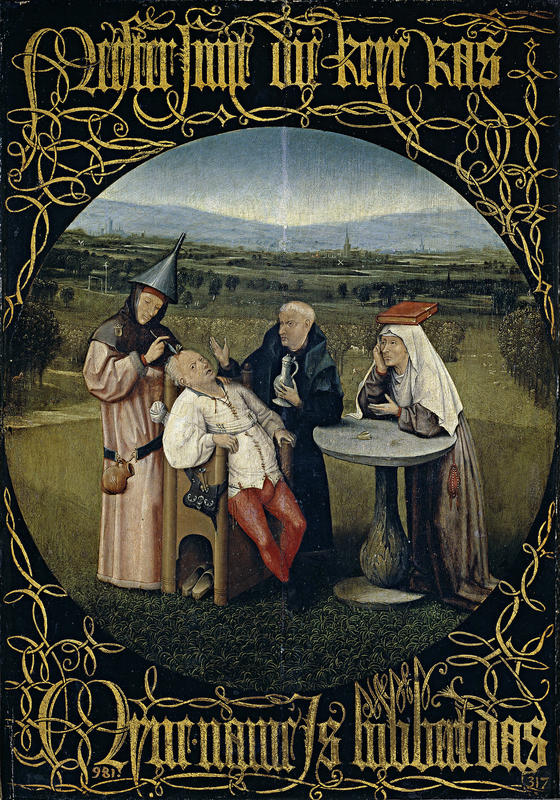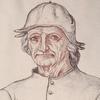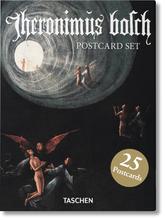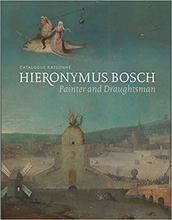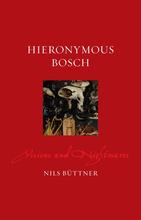More about The Extraction of the Stone of Madness
- All
- Info
- Shop

Sr. Contributor
Insanity has fascinated doctors, artists, and humanists for centuries; with his array of fanciful interests, it’s no surprise that Hieronymus Bosch also took up the subject.
Like the Melancholia of Albrecht Durer, artists have challenged themselves to depict various mental states, like depression and madness, for a long time. Looking at these artworks provides some insight into how the idea of insanity has changed over the centuries.
Generally, mental illness has been grossly misunderstood and gets a bad rap. We’ve gotten a bit better at identifying and treating it, but we didn’t start out so strong. Goya’s The Madhouse exposes the perverse conditions and depraved behavior that dominated the for-profit psych hospitals of the eighteenth century. But fast forward a few centuries, and the electroshock therapy that Sylvia Plath describes in "The Bell Jar" doesn’t seem much better.
Whereas the Bible explains madness as devils overtaking people’s bodies, Bosch’s example sheds some light on the earlier years of diagnosing the causes of mental illness. As people began to understand biology, early scientists began to speculate that the sources of ailments could be found inside the body. Despite the errors of their thinking, they were getting a bit closer to the truth than devils and spirits.
Take a closer look, and you’ll realize how nefarious this image actually is. The first clue is the setting – I’ve heard of open-heart surgery, but open-air? I don’t think this would fly no matter how primitive the medicine might have been. The man we’d like to believe is a doctor is actually a fraud. Other than the strange surgical setting, the upside down funnel on his head, akin to a sixteenth-century dunce’s cap, symbolizes that he’s a quack. His unsuspecting victim is a country peasant who unfortunately doesn’t know any better.
As this quack doctor reaches into his victim’s head, he doesn’t find the stone that he expected, but rather, a water lily. Apparently, lots of people have these just hanging out in their heads, as there is another water lily on the table left from a previous operation. The water lily might highlight the doctor’s fraudulent ways. Or, since everything is always about sex anyway, it might refer to an unintended effect of the lobotomy – the loss of the patient’s sex drive. The inscription encircling the image refers to the name Lubbert Das, which translates to castrated badger, which fits with that theory.
The upside down funnel, one of the earliest symbols of insanity, is the most enduring element of this painting. The questionable mental state of the doctor begs the question: who’s more insane, the unwitting victim or the quack doctor performing this bogus surgery? If we consider the complexities of Bosch’s work, we must consider the pitfalls of the human ego. What is the doctor’s motivation for extracting so many water lilies and ultimately ruining these people? Is it to believe that he is doing something good, or is it the result of his own madness? Along with his strange imagery, these complex questions drew the Surrealists to his work, and keep us coming back for more.
Sources
- Jensen, Katrine Oogard. “Extracting the Stone of Madness.” Three Percent. University of Rochester. http://www.rochester.edu/College/translation/threepercent/2017/04/16/ex…. Access
- Museo del Prado. “The Cure of Folly, or the Extraction of the Stone of Madness.” The Collection. https://www.museodelprado.es/en/the-collection/art-work/extracting-the-…. Accessed 24 September 2019.
- Povoledo, Elisabetta. “In Rome, a New Museum Invites a Hands-On Approach to Insanity.” Art & Design. 27 October 2008. https://www.nytimes.com/2008/10/28/arts/design/28insa.html?partner=rssn…. Accessed 24 September 2019.
- Scull, Andrew. “Madness and Meaning.” The Paris Review. 22 April 2015. https://www.theparisreview.org/blog/2015/04/22/madness-and-meaning/. Accessed 24 September 2019.
- The Art Story. “Hieronymus Bosch.” Artists. https://www.theartstory.org/artist/bosch-hieronymus/. Accessed 24 September 2019.
Featured Content
Here is what Wikipedia says about Cutting the Stone
Cutting the Stone, also called The Extraction of the Stone of Madness or The Cure of Folly, is an oil-on-panel painting completed c.1494 or later by the Dutch painter Hieronymus Bosch. It is now in the Museo del Prado in Madrid.
The painting depicts a surgeon, wearing a funnel hat, removing the stone of madness from a patient's head by trepanation. An assistant, a monk bearing a tankard, stands nearby. Playing on the double-meaning of the word kei (stone or bulb), the stone appears as a flower bulb, while another flower rests on the table. A woman with a book balanced on her head looks on.
The inscription in gold-coloured Gothic script reads:
(Middle Dutch):
Meester snyt die keye ras
Myne name Is lubbert Das
(English):
Master, cut the stone out, fast.
My name is Lubbert Das.
Lubbert Das was a comical (foolish) character in Dutch literature.
Check out the full Wikipedia article about Cutting the Stone

